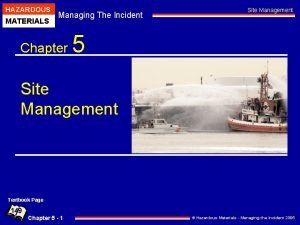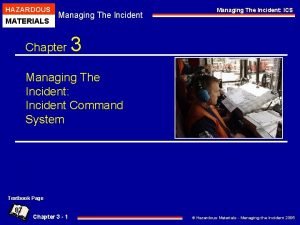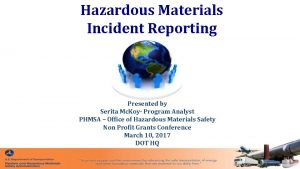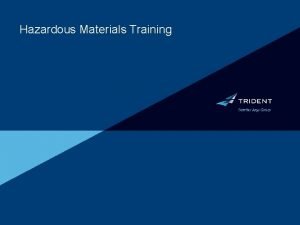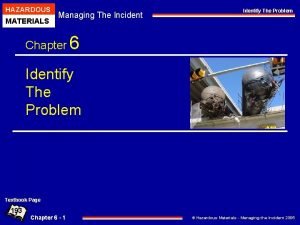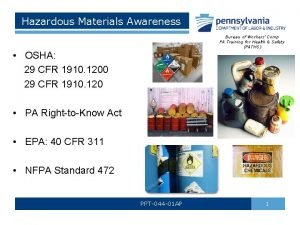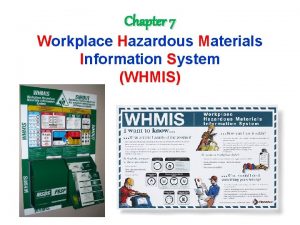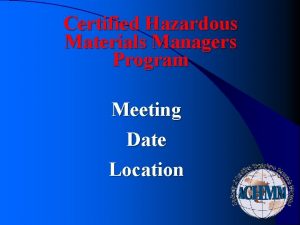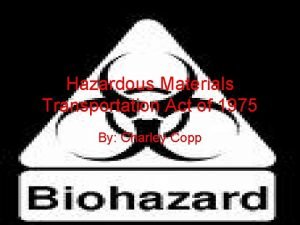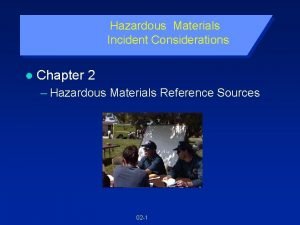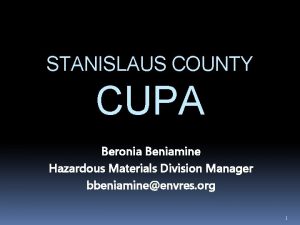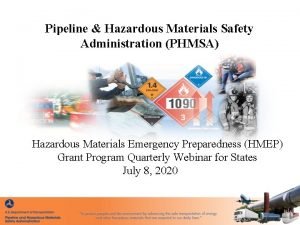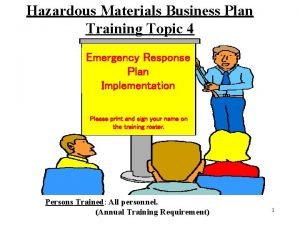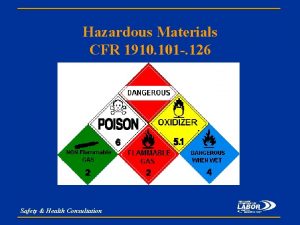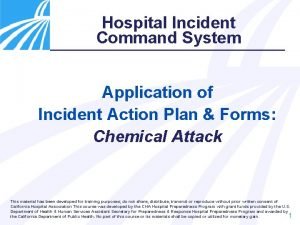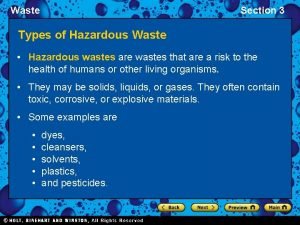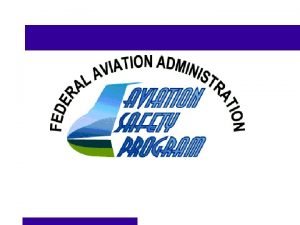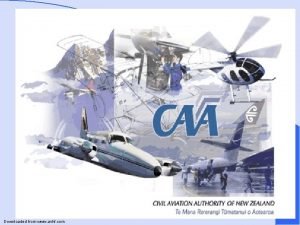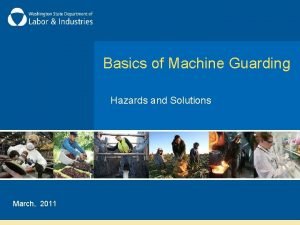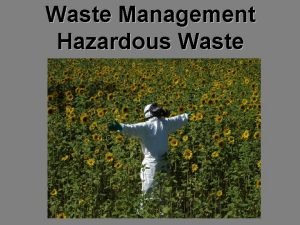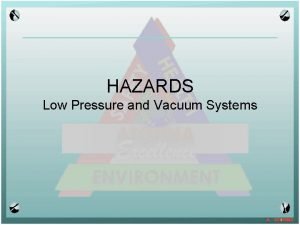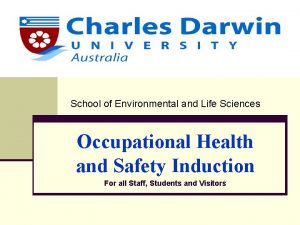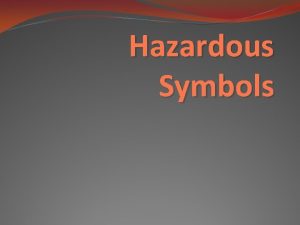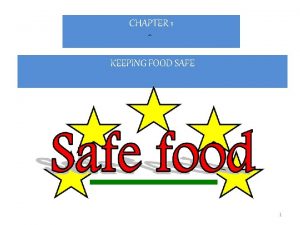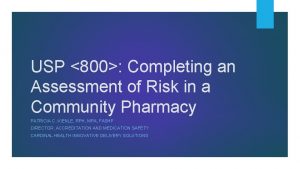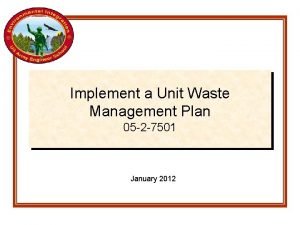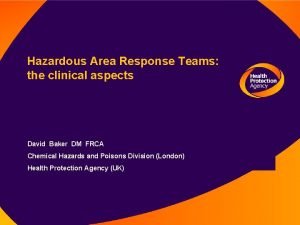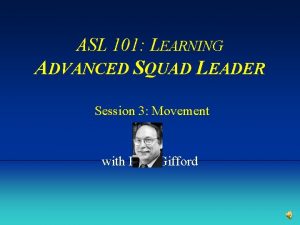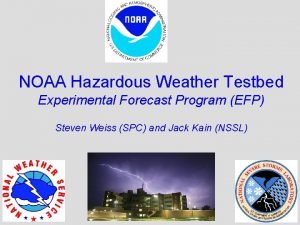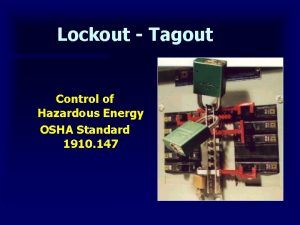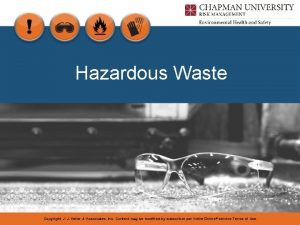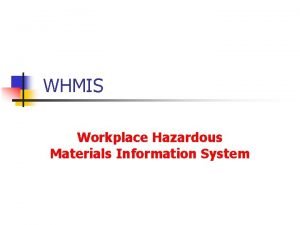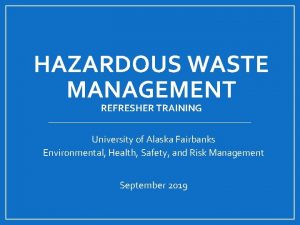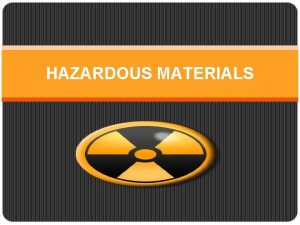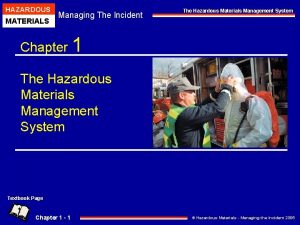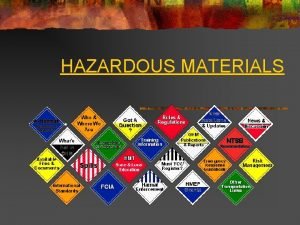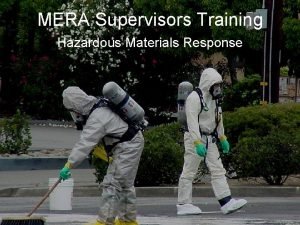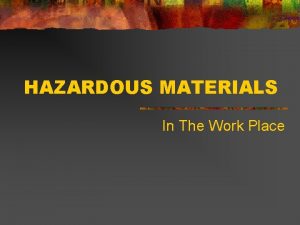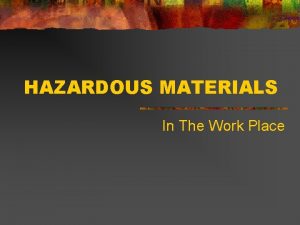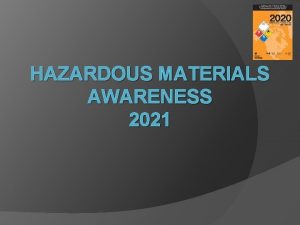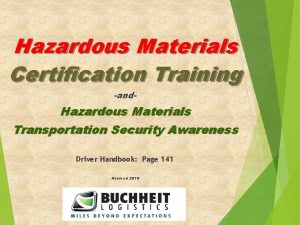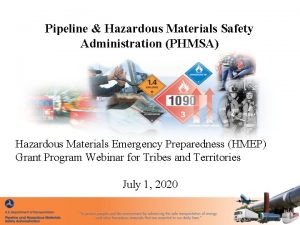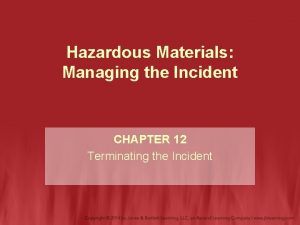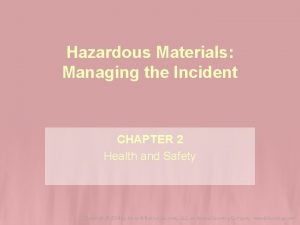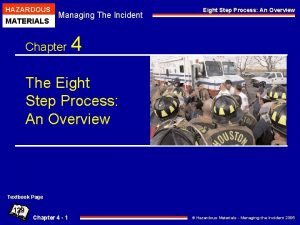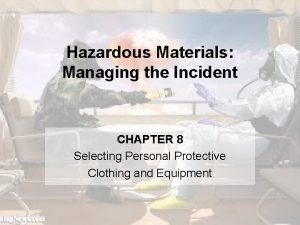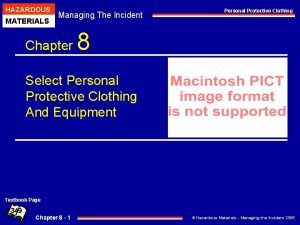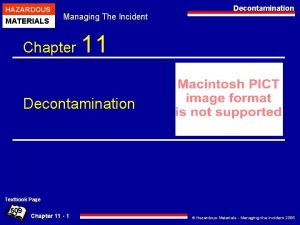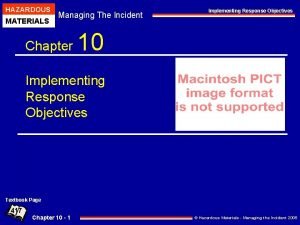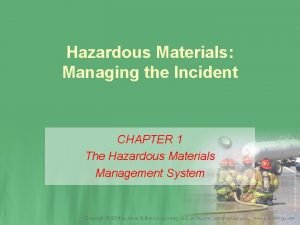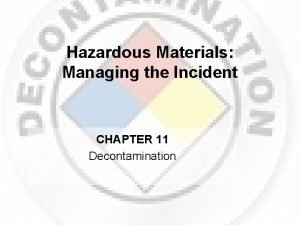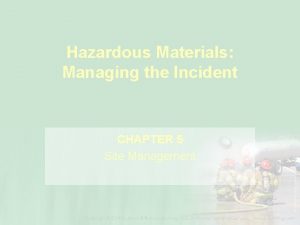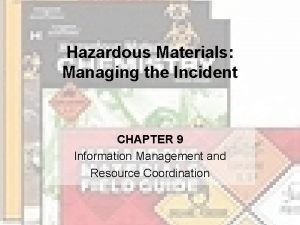Hazardous Materials Managing the Incident CHAPTER 3 Managing
































































- Slides: 64

Hazardous Materials: Managing the Incident CHAPTER 3 Managing the Incident: Problems, Pitfalls, and Solutions

Learning Objectives Overview • Knowledge Objectives • Skills Objectives

Introduction • Direct and effective command control operations are essential • Hazardous materials incidents place a special burden on the command system – Often involves communications among separate agencies – Coordination of many different functions and personnel assignments

Managing the Incident: The Players (1 of 5) Hazardous materials incidents can bring many different players and agencies to the scene.

Managing the Incident: The Players (2 of 5) • A hazmat incident requires different skill sets. • Each response discipline brings its own: – Agendas – Organizational structures – Priorities

Managing the Incident: The Players (3 of 5) • The basic ICS organization includes: – – The incident commander Unified commanders ICS general staff ICS command staff

Managing the Incident: The Players (4 of 5) • ICS players: – – – Fire/rescue/EMS companies Law enforcement officers Emergency response team Hazardous materials response teams Special operations teams

Managing the Incident: The Players (5 of 5) • ICS players (cont’d): – – Facility managers Support personnel Technical specialists Environmental clean-up contractors – Government officials

Managing the Incident: The IC • Responsible for establishing and managing the overall IAP • Includes – Developing an effective organizational structure – Developing an incident strategy and tactical action plan – Allocating resources – Making appropriate assignments – Managing information – Continually attempting to achieve the basic command goals in a safe and competent manner

Managing the Incident: Command Staff • Those individuals appointed by and directly reporting to the IC – Safety officer – Liaison officer – Public information officer

Managing the Incident: General Staff • The mechanism to divide and delegate tasks and develop a management structure to handle the overall control of the incident. – Section chiefs • responsible for the broad response functions of operations, planning, logistics, and finance/administration. – branch, group, or division • frontline supervisors who implement tactical objectives to meet the strategies established by the IC within a branch, group, or division

Managing the Incident: Unified commanders (UCs • Command-level representatives from each of the primary responding agencies – The UCs manage their own agency’s actions and make sure all efforts are coordinated through the unified command process. – They may be the lead IC or play a supporting role within the command function.

Managing the Incident: The Incident Command System (1 of 2) • OSHA 1910. 120(q) • Homeland Security Presidential Directive 5 • Experience beyond regulatory and governmental requirements • NIMS is the baseline incident management system.

Managing the Incident: The Incident Command System (2 of 2) • Five major components within NIMS: – – – Preparedness Communications and information management Resource management Command management Ongoing management and maintenance

Incident Management vs. Crisis Management (1 of 3) • Crisis management is an integral element of corporate and industrial organizations. • Experience has shown there is a direct relationship between incident management and crisis management concerns.

Incident Management vs. Crisis Management (2 of 3) • An incident: – Interrupts normal procedures – Has limited and definable characteristics – Has the potential to precipitate a crisis • Examples of incidents may include: – Fires – Hazmat – Medical and rescue emergencies

Incident Management vs. Crisis Management (3 of 3) • Crisis – Unplanned event that can exceed the level of available resources and – Has the potential to impact significantly on an organization • operations • credibility • reputation – May pose a significant environmental, economic, or legal liability

ICS Lessons Learned • ICS must be a foundational element of any successful hazmat response program. • There is no single agency that can effectively manage a major emergency alone. • Plans that are not regularly updated and user friendly do not get used • Plans that are poorly understood by the players are poorly executed in the field

ICS Lessons Learned • The real issue is not only command, but also coordination • Organizations that attempt to maintain the normal organization or bureaucracy in a major event – Will have inherent problems in implementing a timely and effective emergency response

ICS Lessons Learned • Emergency response programs are either “people-dependent” or “system-dependent. ” – HMRTs tend to be people-dependent programs • Special operations teams are often very people-dependent – Rely on the experience of a few key individuals – Can result in failed emergency response efforts if these key individuals are not present • System-dependent organization delivers a consistent level of quality and service – Regardless of personnel or location

ICS Elements • Basic management concepts: – Division of labor – Unity of command – Span of control • Establishment of both line and staff functions within the organization

Common Terminology (1 of 3) • Incident commander: – Single command structure – Unified command – Multiagency coordination center Courtesy of Eric Bachman

Common Terminology (2 of 3) • Sections: – – Operations section Planning section Logistics section Administration/finance section • Branch • Division/groups

Common Terminology (3 of 3) • Command staff officers: – Safety officer – Liaison officer – Public information officer South Central Task Force (GGN)

Modular Organization (1 of 2) • ICS organizational structure develops: – In a modular fashion – Based on the size and nature of the incident – From the top down • IC must be identified on all incidents.

Modular Organization (2 of 2)

Predesignated Incident Facilities (1 of 2) • Incident command post – The ICP is the nerve center of on-scene operations and is usually located near the scene of the emergency. – ICP is primarily oriented towards tactical control issues pertaining to the on -scene response

Predesignated Incident Facilities (2 of 2) • Emergency operations center (EOC) – EOC deals with both strategic and external world issues and coordinates all logistical and resource support for onscene operations – The EOC is normally remote from the emergency scene – EOC should provide: • • Phone, radio, and fax communications Internet access Information technology (IT) resources ability for a large number of personnel to work in a comfortable and secure area

Integrated Communications • Communications are critical to safe and efficient incident management. – IC should be able to communicate directly with all onscene units and support personnel • Critical that the IC be provided with regular and timely progress reports • Communications of a sensitive nature should not be given over nonsecure telephones or radios

Unified Command • Unified command is not management by committee – There must always be a lead agency • Multijurisdictional/ Multiagency – Determining common set of incident objectives and strategies – Developing a single IAP – Maximizing use of all assigned resources – Resolving conflicts between the players

Consolidated Plan of Action • Consolidated action plan ensures: – Common emergency response goal – Agendas are coordinated – Everyone works safely

Consolidated Plan of Action • The IAP consists of: – – Incident priorities Strategic goals Tactical objectives Resource requirements

Comprehensive Resource Management (2 of 2) South Central Task Force (GGN) Implementing an Incident Action Plan without sufficient resources is like writing a check with insufficient funds in the bank.

Managing the Incident: Hazmat Group Operations • Hazardous materials group – Normally under the command of a senior hazmat officer • (hazardous materials group supervisor) – Reports to the operations section chief or the IC • Responsible for all tactical hazmat operations in hot and warm zones • Hazardous materials group primary functions: – Safety function – Entry/back-up function – Decontamination function – Site access control function

Managing the Incident: Hazmat Group Operations § Safety function § Hazardous materials group safety officer § Entry/back-up function § Responsible for all entry and backup operations reconnaissance, monitoring, sampling, and mitigation § Decontamination function § Research and development of the decon plan § Setup, and operation of an effective decontamination area § Site access control function § Establish hazard control zones § monitor egress routes at the incident site § Manage the safe refuge area

Managing the Incident: Hazmat Group Operations • Hazardous materials group secondary functions: – Medical function • Responsible for pre- and post-entry medical monitoring and evaluation • Provides technical medical guidance to the hazardous materials group – Resource function • Responsible for control and tracking of all supplies and equipment used by the hazardous materials group – Coordinates, as necessary, with the logistics section chief

Managing the Incident: Hazmat Group Operations (5 of 5) The Hazmat Group is responsible for all tactical-level hazmat response operations.

Hazardous Materials Group Staffing • Hazardous materials group staffing: – Group supervisor – Trained to the hazardous materials technician level – Group safety officer • Assistant safety officer–hazmat • Responsible for all operations within the hazardous materials group and within the hot and warm zones • Identify and monitor personnel operating within the hot zone

Hazardous Materials Group Staffing • Hazardous materials group staffing: – Entry team & Entry Unit Leader – The entry team is managed by the entry unit leader – Implement all offensive and defensive actions – Direct rescue operations within the hot zone – Back-up team – Safety team that will extract the entry team in the event of an emergency – Entry support personnel – Responsible for the proper donning and outfitting of both the entry and back-up teams

Hazardous Materials Group Staffing • Hazardous materials group staffing (cont’d): – Decontamination team & Decon Officer • Determine the appropriate level of decontamination to be provided • Ensure proper decon procedures are used • Coordinate decon operations with the entry leader – Site access control • Monitor the control and movement of all people and equipment through appropriate access routes • Oversee the placement of the hazard control zone lines • Establish a safe refuge area and appoint a safe refuge area manager

Hazardous Materials Group Staffing – Hazardous materials information/research team • Provide technical support to the hazardous materials group • Research, gather, and compile technical information and assistance • Provide recommendations for the selection and use of protective clothing and equipment • Provide and interpret environmental monitoring information, including the analysis of hazardous materials samples and the classification and/or identification of unknown substances

Hazardous Materials Group Staffing – Hazardous materials medical unit • Provide pre-entry and post-entry medical monitoring • Provide technical assistance for all EMS-related activities • Provide emergency medical treatment and recommendations – Hazardous materials resource unit • Located in the cold zone • Responsible for acquiring all supplies and equipment required for hazardous materials group operations

Managing the Incident: Street Smarts • A hazardous materials response is viewed by the outside world two ways: – “Technical merit” • Did responders make the “problem” go away? – “Artistic impression” • How well did we manage the “external world” effects of the problem – An incident can become a crisis when the political and external issues are not effectively addressed. – An effective field response effort can be compromised or completely negated by poor management of the political and external issues.

Command Control § If command presence is not strong, both individual and organizational “freelancing” can occur. § Those who look they know what they are doing set a tone for the management of the emergency § Plan ahead and operate with a backup plan. § Constant reassessment and possible revision of tactical operations are needed to maximize response effectiveness. § Where will the incident be in 30 minutes? § 60 minutes? § Given the current problem, what is our worst-case scenario?

Incident Potential (1 of 2) • Elements of incident potential can include: – Incident severity – Magnitude and duration of the event – Nature and degree of incident impact – Community impact – External world and media affairs impact – Legal concerns Situational awareness and assessment of incident potential go hand-in-hand

Incident Potential (2 of 2) • Causes of a delayed assessment of incident potential include: – – – Loss of “big picture” Do-it-all attitude Failure to request aid Downplaying the problem Inexperience Lack of information

Decision Making § Begins with both Command the hazmat group supervisor recognizing the need to avoid dead-end decisions § Recognize: § Distinction between assumptions and facts § Response operations must sometimes be based upon incomplete or assumed information. § Factual information is often not available or is incomplete § A flexible approach to decision making § Regular feedback allows for revisions to the general strategy, specific tactics, and all major decisions. § A shift to a management role after initiating action § An IC cannot make all ongoing response decisions

Definition of “Assume” OF & ?

Information is Power (1 of 2) • Information may become random – Requires time to gather – Has a “half-life” • Is valuable for a limited period of time – Tactical worksheets can help • Reluctance to provide timely information – True picture vs. made-up

Information is Power (2 of 2) Regular situation status reports must flow from the Operations Section to the Incident Commander.

The Rules of Engagement • ROE provides the structure for engaging the enemy, including: – – Chain of command Decision-making authority Accountability Responsibility • ROE should clarify the relationship between the IC and the HMRT. • Deal with unacceptable risk.

Liaison Officer • Liaison is: – A member of command staff – Viewed as “political officer” – Point of contact for: • Assisting agencies • Cooperating agencies

What You See Is Not Necessarily What You Get (1 of 2) • Underestimating the significance of a hazmat emergency can increase the level of risk to both responders and the public. • Consistently overreacting is also a problem and can damage the credibility of emergency responders. • A problem may be perceived when there is not an emergency but physical indicators are present. • Public intolerance is directly proportional to the length of time citizens are inconvenienced.

Working with Technical Specialists (1 of 2) Technical specialists and environmental clean-up contractors can be key players in the safe and successful management of a hazmat incident. https: //video. search. yahoo. com/video/play? p=Overt urned+Truck+rolls+away+video&vid=7 aa 6 cf 6622 845 d 1 c 27205 c 1 d 4 dcd 7743&turl=http%3 A%2 F%2 Ftse 3. mm. bing. net%2 Fth%3 Fid%3 DWN. zdv. GFP HIk. Du 79 P%252 b 1 VKc%252 f. Dw%26 pid%3 D 15. 1 %26 h%3 D 225%26 w%3 D 300%26 c%3 D 7%26 rs%3 D 1&rurl=http%3 A%2 F%2 Fwww. ebaumsworld. co m%2 Fvideo%2 Fwatch%2 F 82194696%2 F&tit=To w+Truck+Rolls+over&c=15&h=225&w=300&l=5 6&sigr=11 gj 4 bthf&sigt=10 k 5 o 2 tsh&sigi=12 pr 5 h 2 h 6&ct=n&age=1326427200&fr 2=p%3 As%2 Cv%3 Av&fr=yhs-mozilla-004&hsimp=yhs 004&hspart=mozilla&tt=b http: //www. ebaumsworld. com/video/watch/82194696/

Working with Technical Specialists (2 of 2) • Consider: – Specific technical area vs. multi-disciplined nature of emergency response – Knowledge in a structured and controlled environment – No experts, but only information sources – No previous contact – Questioning information sources – Rule of threes

The Eternal Optimists • Remember the PACE model for planning: – – Have a primary plan Have an alternate plan Have a contingency plan Have an emergency plan • If you only ask if everything is okay, don’t be surprised when your people consistently say it is.

Long-Term Incidents and Planning • The majority of hazmat incidents are high intensity – short duration events that are terminated in 8 hours or less. • Campaign incidents extending over a period of days or weeks create different challenges for emergency responders – Issues • Developing a shift schedule, • Determining short-term and long-term logistical requirements • establishing a formal IAP development flow and process.

Final Thoughts (1 of 3) • The effective IC will: – – – Seek out current, accurate, and specific data Delegate information retrieval Know where to find and how to use reference data Collect the right information in the right order Use a wide variety of sources of information

Final Thoughts (2 of 3) • Solicit opinions and ideas. • Those taking risks should have an equal voice in the decision-making process. • Be careful to avoid “groupthink. ” • Never say never. • Consider the art of communications.

Final Thoughts (3 of 3) • When an incident goes bad or is particularly politically sensitive, anticipate being the scapegoat. • In order to minimize political vulnerability, the IC must continuously: – Consult and build a consensus within the IAP – Document – Assume nothing

Summary (1 of 4) • The successful management of a hazmat incident is directly linked to the rapid development of an effective incident management process and organization. • A variety of different players will respond to a working hazmat incident. • There is no single organization that can effectively manage a major hazmat incident.

Summary (3 of 4) • If ICS is not used for all routine emergencies, don’t expect it to function when a major emergency occurs. • The hazardous materials group: – Reports to the operations section chief – Is managed by a group supervisor – Contains an ASO−hazmat

Summary (2 of 4) • There is no single organization that can effectively manage a major hazmat incident. • The point of contact for the media and other organizations? • The hazardous materials group supervisor must be trained to what NFPA level?

Summary (4 of 4) • An effective response effort can be compromised or completely negated by poor management of the political and external issues. • Individuals who provide specific expertise to the IC and emergency responders? • _____ is the baseline incident management system established under Homeland Security Presidential Directive 5
 Hazardous materials managing the incident
Hazardous materials managing the incident Hazardous materials managing the incident
Hazardous materials managing the incident Hazardous materials incident report
Hazardous materials incident report Dot
Dot Hazardous materials table
Hazardous materials table Us military marking system for hazardous materials
Us military marking system for hazardous materials Hazwoper
Hazwoper Shape and color of whmis 2015 symbols
Shape and color of whmis 2015 symbols Isachmm
Isachmm Hazardous materials transportation act of 1975
Hazardous materials transportation act of 1975 Hazardous materials reference books
Hazardous materials reference books Stanislaus county hazardous materials division
Stanislaus county hazardous materials division Pipeline and hazardous materials administration
Pipeline and hazardous materials administration Hazardous materials business plan
Hazardous materials business plan 29 cfr 1910 hazardous materials
29 cfr 1910 hazardous materials Incident objectives that drive incident operations
Incident objectives that drive incident operations Cant stop the feeling trolls go noodle
Cant stop the feeling trolls go noodle How would you differentiate useful from harmful materials
How would you differentiate useful from harmful materials Natural materials and man made materials
Natural materials and man made materials Differentiate adopting materials and adapting materials
Differentiate adopting materials and adapting materials Direct materials budget with multiple materials
Direct materials budget with multiple materials Section 3 hazardous waste answers
Section 3 hazardous waste answers Aviation hazardous attitudes
Aviation hazardous attitudes Hospital waste management introduction
Hospital waste management introduction Avhf
Avhf 5 hazardous attitudes
5 hazardous attitudes Hazardous mechanical motion
Hazardous mechanical motion Msw apes
Msw apes What is toxic waste
What is toxic waste Nj crtk environmental hazardous substances
Nj crtk environmental hazardous substances Vacuum hazards
Vacuum hazards Hazardous area training darwin
Hazardous area training darwin Hazardous symbols
Hazardous symbols Keeping food safe chapter 1
Keeping food safe chapter 1 Hazardous drug api
Hazardous drug api On july 18 2001 a train carrying hazardous chemicals
On july 18 2001 a train carrying hazardous chemicals Segregation of hazardous waste
Segregation of hazardous waste Hazardous area response teams
Hazardous area response teams Hazardous movement asl
Hazardous movement asl Solid and hazardous waste
Solid and hazardous waste Noaa experimental forecast
Noaa experimental forecast Tagout
Tagout Keller hazardous waste disposal
Keller hazardous waste disposal Hazardous chemicals
Hazardous chemicals Rcra hazardous waste refresher
Rcra hazardous waste refresher Hát kết hợp bộ gõ cơ thể
Hát kết hợp bộ gõ cơ thể Lp html
Lp html Bổ thể
Bổ thể Tỉ lệ cơ thể trẻ em
Tỉ lệ cơ thể trẻ em Chó sói
Chó sói Chụp tư thế worms-breton
Chụp tư thế worms-breton Hát lên người ơi
Hát lên người ơi Môn thể thao bắt đầu bằng từ đua
Môn thể thao bắt đầu bằng từ đua Thế nào là hệ số cao nhất
Thế nào là hệ số cao nhất Các châu lục và đại dương trên thế giới
Các châu lục và đại dương trên thế giới Cong thức tính động năng
Cong thức tính động năng Trời xanh đây là của chúng ta thể thơ
Trời xanh đây là của chúng ta thể thơ Mật thư tọa độ 5x5
Mật thư tọa độ 5x5 Phép trừ bù
Phép trừ bù Phản ứng thế ankan
Phản ứng thế ankan Các châu lục và đại dương trên thế giới
Các châu lục và đại dương trên thế giới Thể thơ truyền thống
Thể thơ truyền thống Quá trình desamine hóa có thể tạo ra
Quá trình desamine hóa có thể tạo ra Một số thể thơ truyền thống
Một số thể thơ truyền thống Cái miệng bé xinh thế chỉ nói điều hay thôi
Cái miệng bé xinh thế chỉ nói điều hay thôi
